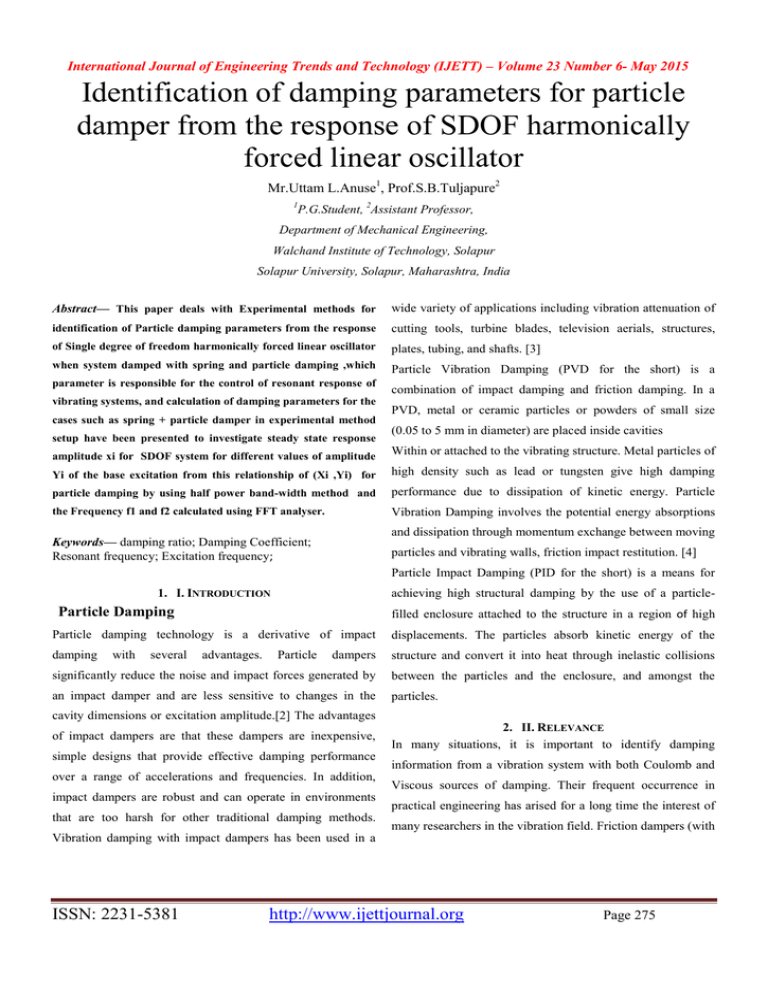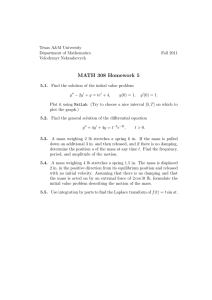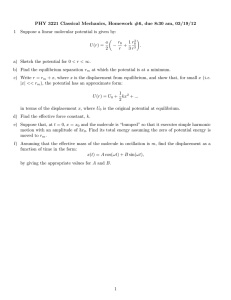Identification of damping parameters for particle forced linear oscillator
advertisement

International Journal of Engineering Trends and Technology (IJETT) – Volume 23 Number 6- May 2015 Identification of damping parameters for particle damper from the response of SDOF harmonically forced linear oscillator Mr.Uttam L.Anuse1, Prof.S.B.Tuljapure2 1 P.G.Student, 2Assistant Professor, Department of Mechanical Engineering, Walchand Institute of Technology, Solapur Solapur University, Solapur, Maharashtra, India Abstract— This paper deals with Experimental methods for wide variety of applications including vibration attenuation of identification of Particle damping parameters from the response cutting tools, turbine blades, television aerials, structures, of Single degree of freedom harmonically forced linear oscillator plates, tubing, and shafts. [3] when system damped with spring and particle damping ,which Particle Vibration Damping (PVD for the short) is a parameter is responsible for the control of resonant response of vibrating systems, and calculation of damping parameters for the cases such as spring + particle damper in experimental method setup have been presented to investigate steady state response combination of impact damping and friction damping. In a PVD, metal or ceramic particles or powders of small size (0.05 to 5 mm in diameter) are placed inside cavities amplitude xi for SDOF system for different values of amplitude Within or attached to the vibrating structure. Metal particles of Yi of the base excitation from this relationship of (Xi ,Yi) for high density such as lead or tungsten give high damping particle damping by using half power band-width method and performance due to dissipation of kinetic energy. Particle the Frequency f1 and f2 calculated using FFT analyser. Vibration Damping involves the potential energy absorptions and dissipation through momentum exchange between moving Keywords— damping ratio; Damping Coefficient; Resonant frequency; Excitation frequency; particles and vibrating walls, friction impact restitution. [4] Particle Impact Damping (PID for the short) is a means for 1. I. INTRODUCTION achieving high structural damping by the use of a particle- Particle Damping filled enclosure attached to the structure in a region of high Particle damping technology is a derivative of impact displacements. The particles absorb kinetic energy of the damping dampers structure and convert it into heat through inelastic collisions significantly reduce the noise and impact forces generated by between the particles and the enclosure, and amongst the an impact damper and are less sensitive to changes in the particles. with several advantages. Particle cavity dimensions or excitation amplitude.[2] The advantages of impact dampers are that these dampers are inexpensive, simple designs that provide effective damping performance over a range of accelerations and frequencies. In addition, impact dampers are robust and can operate in environments that are too harsh for other traditional damping methods. 2. II. RELEVANCE In many situations, it is important to identify damping information from a vibration system with both Coulomb and Viscous sources of damping. Their frequent occurrence in practical engineering has arised for a long time the interest of many researchers in the vibration field. Friction dampers (with Vibration damping with impact dampers has been used in a ISSN: 2231-5381 http://www.ijettjournal.org Page 275 International Journal of Engineering Trends and Technology (IJETT) – Volume 23 Number 6- May 2015 viscous damping as the system damping) are used in gas turbine engines, high speed turbo pumps, large flexible space structures under carriage of railway bogie, vehicle suspension systems etc. These dampers are used to reduce resonant stresses by providing sliding contact between points experiencing relative motion due to vibration, thereby dissipating resonant vibration energy. The distribution and arrangement of the multiple particle dampers on the structure usually have a significant impact on the damping effect of the dampers. It is seen that the identification and estimation of the numerous forms of damping present in a dynamic system is helpful in improving Fig.1 Schematic of the experimental arrangement (b) A magnified view of the particles inside the enclosure [21] the control of resonant response. As such, some theoretical and experimental studies on “Development of Theoretical and Experimental Methods for Identification of Coulomb, Viscous and Particle Damping Parameters from the Responses of a SDOF Harmonically Forced Linear Oscillator” have been carried out. When a vibrating system is damped with more than one type of models of damping, it is necessary to determine which of these types of damping are more effective to control the resonant response. In such case, it is important to identify damping parameters from the responses of a vibrating system. Therefore when a system is damped due to Coulomb friction, viscous friction and Particle damping, it is necessary to develop theoretical & Experimental methods for identification of these damping parameters from the responses Fig.2The model of a single degree of freedom system of a particle vibration damper22] of the vibrating system. As such, it is proposed to develop methods for identification of Coulomb and Viscous friction (and also with Particle damping) parameters responsible for the control of resonant response of vibrating systems. For this purpose, following work has been carried out. ISSN: 2231-5381 http://www.ijettjournal.org Page 276 International Journal of Engineering Trends and Technology (IJETT) – Volume 23 Number 6- May 2015 Fig. 3 particle vibration damper (left) and the particle contacts the base of the springs has been excited by an electrodynamic (right).[22] exciter. The Viscous damper is attached between Centers of the mass and the “C” frame. Two Particle dampers have been attached. One end of the particle damper is connected to the mass and other end of the damper is kept free. Two Coulomb dampers have been attached between the mass and end plate of the “C‟ frame. The frequency response curve of the system is obtained using the accelerometer pick up with its necessary attendant equipment and a FFT analyzer, over a small range of • excitation frequency. Half Power Band-Width Method: • To estimate damping ratio from frequency domain, (frequency response curve) half-power bandwidth method can be used. In SYSTEM PARAMETERS k, m A plate of 1.0 kg has been used and the natural frequency of system alone was chosen as 8.75 Hz, (54.97 rad/sec) and this method, resonant amplitude of the system is obtained first. Corresponding to each natural frequency, there is a peak using the equation, n in Frequency Response Function (FRF) amplitude. On decibel scale, 3 dB down from the peak there are two points corresponding to half power point. The more the damping, more the frequency range between this two points. Half-power bandwidth Band width is defined as the ratio of the frequency range (f2-f1) between the two half power points to the natural frequency (fn) at this mode. It is related to damping ratio as, 2 f 2 f1 . fn IV. EXPERIMENTALTEST SET-UP AND THE PLAN OF INSTRUMENTATION A schematic of the experimental test set-up is shown in the k spring stiffness k was obtained m as 3022 N/m. Thus the values of the parameters of SDOF system are m=1.0 kg and k= 3022 N/m. Design of springs of Stiffness k1 /2 Two parallel springs each of stiffness of k1/2 = 1511 N/m have been designed for the experimental work. The springs selected are helical compression with both ends squared and ground. The dimensions of springs are obtained using standard formulae of design of helical compression spring. The material of springs is selected as high grade spring steel. The final dimensions of the spring are as follows. Following are the design specifications. TABLE 1 – DESIGN SPECIFICATION OF SPRINGS FOR fig. (4.1).A plate which is made to move in the horizontal SDOF SYSTEM direction in two guide bars, represents the mass m of the system. It is connected on two parallel springs of equal Parameters stiffness k1/2 each as shown in figure (4.1). Linear bearings Spring stiffness k1/2=1511 N/m Number of turns (N) 14 and guide bars. A heavy “C” frame has been used for fixing Wire diameter (d) 4mm the guide bars as shown in figure. On the left side of mass, a Mean diameter (D) 38 mm Outer diameter (D0) 42 mm Inner diameter (Di) 34 mm Spring index (C) 10 have been used to reduce friction in between the mass plate viscous damper, two Coulomb dampers and two particle dampers have been attached. While, on the right side of mass, ISSN: 2231-5381 http://www.ijettjournal.org Page 277 International Journal of Engineering Trends and Technology (IJETT) – Volume 23 Number 6- May 2015 The frequency response curve for 300 balls inside the Determination of system damping + particle pipe case is shown in figure (4.9). Using the half power band- damping (s+p ) Particle Vibration Damping is a combination of impact width method, the value of system damping ratio s+pwith no damping and friction damping. In a PVD, metal or ceramic balls has been determined as, particles or powders of small size (0.05 to 5 mm in diameter) s p are placed inside cavities within or attached to the vibrating f 2 f1 8.037 7.102 = = 0.06233 2 fn 2 7.5 structure. The particles absorb kinetic energy of the structure and convert it into heat through inelastic collisions between iv) Particle damping with fully filled balls inside pipe The frequency response curve for fully filled balls the particles and the enclosure, and amongst the particles. In the experimental set-up, stainless steel balls of small size inside the pipe case is shown in figure (4.10). Using the half (3.18 mm in diameter) are placed inside pipe (of diameter power band-width method, the value of system damping ratio 20mm and length 80 mm). The pipe is closed from both ends. s+pwith no balls has been determined as, One end of pipe is attached to the vibrating mass and other s p end is kept free. In this case, the SDOF spring mass system with particle f 2 f1 8.08 6.92 = = 0.07784 2 fn 2 7.5 TABLE 2. DAMPING RATIO OF VARIOUS DAMPING COMBINATION damping has been excited from 5 Hz to 12 Hz using electro dynamic exciter and the steady state response X has been measured using an accelerometer and FFT analyzer. The readings were taken by increasing the number of balls inside the pipe, starting from no balls to full filled balls inside the pipe. i) Particle damping with no balls inside pipe The frequency response curve for no balls inside the pipe case is shown in figure (4.7). Using the half power bandwidth method, the value of system damping ratio s+pwith no Type of damping S S+P(T:No balls) S+P(T:200 balls) S+P(T:300 balls) S+P(T:fully filled with balls) fr(Hz) Xr (microns) f1 f2 8.75 4647.5 8.314 9.243 0.053 7.5 6815 7.289 7.9 0.04 7.5 6325 7.308 8.2 0.059 7.5 6095 7.102 8.037 0.0623 7.5 4395 6.92 8.08 0.0778 balls has been determined as, s p f 2 f1 7.9 7.289 = = 0.04 2 fn 2 7.5 ii) Particle damping with 200 balls inside pipe The frequency response curve for 200 balls inside the pipe case is shown in figure (4.8). Using the half power bandwidth method, the value of system damping ratio s+pwith no balls has been determined as, s p f 2 f1 8.2 7.308 = = 0.059 2 fn 2 7.5 iii) Particle damping with 300 balls inside pipe Fig.4. Experimental Setup with particle damper ISSN: 2231-5381 http://www.ijettjournal.org Page 278 International Journal of Engineering Trends and Technology (IJETT) – Volume 23 Number 6- May 2015 S+P(full balls) 5000 4500 X (microns) 4000 3500 3000 2500 2000 1500 1000 500 0 4 5 6 7 8 9 10 11 12 f (Hz) Fig.4.9. Frequency response curve for ξs+p fn=7.5 Hz ; f1= 6.92 Hz ;f2= 8.08 Hz ξ=0.0778; Xr=4395 µm 3. V. CONCLUSION Particle dampers significantly reduce the noise and impact forces generated by an impact damper and are less sensitive to changes in the cavity dimensions or excitation amplitude.[2] The advantages of impact dampers are that these dampers are inexpensive, simple designs that provide effective damping performance over a range of accelerations and frequencies. i) For s+p(no ball condition)with resonant frequency equal to 7.5 Hz . Using the half power band-width method, the value of system damping ratio has been determined as s+p = 0.04. For s+p(200 balls) with resonant frequency equal to 7.5 Hz . Using the half power band-width method, the value of system damping ratio has been determined as s+p = 0.059 For s+p(300 balls)with resonant frequency equal to 7.5 Hz . Using the half power band-width method, the value of system damping ratio has been determined as s = 0.0623. iv) For s+p(fully filled) with resonant frequency equal to 7.5 Hz. Using the half power band-width method, the value of system damping ratio has been determined as s+p = 0.0778 ISSN: 2231-5381 http://www.ijettjournal.org Page 279 International Journal of Engineering Trends and Technology (IJETT) – Volume 23 Number 6- May 2015 7. REFERENCES 1. 2. 3. 4. 5. 6. [1] J.W. Liang, and B.F. Feeny, 2004,“Identifying Coulomb and Viscous Friction in Forced Dual-Damped Oscillators,” ASME J. Vib. Acoust., 126, pp. 118–125. [2] Steven E. Olson, 2003, ”An analytical particle damping model” J. Sound Vib. 264, pp.1155–1166. [3] M.R. Duncan, C.R. Wassgren and C.M. Krousgrill 2005,“The damping performance of a single particle impact damper”, J. Sound Vib. 286, pp.123–144. [4] Mao, K. M., Wang, M. Y., Xu, Z. W., and Chen, T. N., 2004, „„Simulation and Characterization of Particle Damping in Transient Vibrations,‟‟ ASME J. Vib. Acoust., 26,pp.202-211. [5] Den Hartog, J. P., 1931, „„Forced Vibrations with Combined Coulomb and Viscous Friction,‟‟ Trans. ASME, 53, pp. 107–115. [6] Hundal, M. S., 1979, „„Response of a Base Excited System with Coulomb and Viscous Friction,‟‟ J. Sound Vib.,64, pp. 371–378. ISSN: 2231-5381 8. 9. E.S. Levitan, 1960, “Forced Oscillation of a spring-mass system having combined Coulomb and Viscous damping,” Journal of the Acoustical Society of America 32, pp.1265-1269. [8]Thomas A. Perls and Emile S. Sherrard 1956, “Frequency Response of Second Order Systems with Combined Coulomb and Viscous Damping,” Journal of Research of the National Bureau of Standards, 57, pp.45-64. [9] J.W.Liang, and .F.,Feeny, 1999, The Estimation of Viscous and Coulomb Damping in Harmonically Excited Oscillators,” Proceedings of DETC 99, Las Vegas, 10. 11. http://www.ijettjournal.org Page 280








